HDMS Niels Juel (1918)
 Denmark Coast Defence ship laid down 1914, rebuilt 1918, 1929, 1937, captured 1943
Denmark Coast Defence ship laid down 1914, rebuilt 1918, 1929, 1937, captured 1943
HDMS Niels Juel was a Danish warship built in WWI, named after probably the most famous Danish admiral of the 17th century, winning a battle against Sweden. Initially she was laid down in 1914, and classified as a coastal defense ship, but later as an armoured cruiser, and rearmed as such in 1918. She was modernized in 1929 and 1935-1936. During World War II, HDMS Niels Juel served served with the Danish Navy, neutral but occupied by the Germans. Her fate was settled at the Battle of Isefjord 29 August 1943 by the Luftwaffe. She was beached and captured, re-floated and recommissioned as KMS Nordland, but scuttled again in 1945. #ww1 #ww2 #danishnavy #nielsjuel
Design development of Niels Juel
A Coastal Battleship (1914)
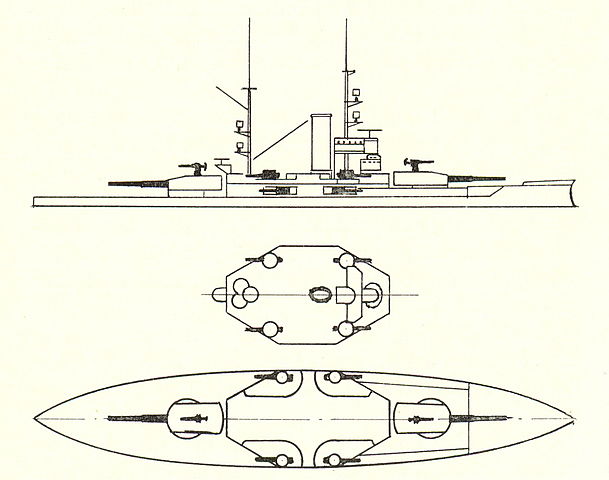
Niels Juel first 1914 design, with two 305 mm guns (12-in).
Defined as the new Coastal battleship, HDMS Niels Juel was laid down in September 1914. She was sightly larger than Peder Skram, but featured a more modern propulsion, with mixed coal/oil boilers and a heavier armament: Two 12-inch guns (305 mm) as initially planned. Most importantly she had a taller hull with better seakeping, fit for the high seas, rather than the monitor-like low freeboard of the previous Peder Skram. The Krupp guns however were seized by the German army before delivery in August 1914 and soon converted into railroad artillery.
Her initial data comprised the following:
Displacement 3,800/4,100t, two 12-in(305mm) guns in single turrets for and aft, eight 120mm QF guns (as of 1917) in side casemates open deck mounts, two 75mm AA guns admiship.
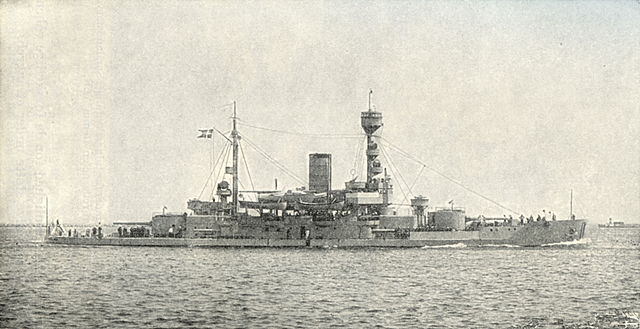
The previous HDMS Peder Skram in 1908
Therefore, not only construction was stopped and resumed slowly, but the ,naval staff had to rethink the design entirely. In addition further delays came with the Copenhagen navy yard being busy trying to maintain the existing fleet now the country had to provide an extensive neutrality patrol service to protect its assets and trade. After the war ended the Allies forbade Krupp to honor the contract, leaving the Danish Navy little choice but to completely change the original coastal battleship layout into something else.
Redesign as armoured cruiser (1918)
The Danish admiralty looked at other providers for the main artillery, not willing to compromise the design too much, but they were opposed by the Danish parliament, which estimated that heavy guns should look theatening to neighbours, notably Germany, and instead looked to purchase ten 150mm (5.9-inch) guns from Bofors, Sweden. Thy also asked the design should be changed into a training vessel instead. The tall and roomy hull could help in this already. The main guns had to be at least shielded, placed in a pair forward and superfiring pair aft, with three more on each broadside amidships. Thus, apart its stocky and tall appearance, Niels Juel was much closer to a cruiser.
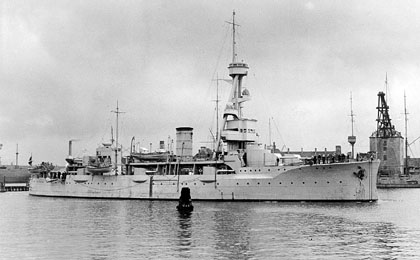 Procurement of the guns, before Sweden accepted, was difficult. France, UK and Sweden competed and their offers rejected until an agreement was found with Bofors. A secondary armament of 120 mm (4.7 in guns) was asked for by the Admiralty, based on 1917 post-Jutland battle reports. They showed this intermediate, quick-firing caliber was still quite effective. But there was no room left and it was dropped, as the proposal to keep four 15 cm and the rest in 12 cm for the sake of supply and fire homogeneity.
Procurement of the guns, before Sweden accepted, was difficult. France, UK and Sweden competed and their offers rejected until an agreement was found with Bofors. A secondary armament of 120 mm (4.7 in guns) was asked for by the Admiralty, based on 1917 post-Jutland battle reports. They showed this intermediate, quick-firing caliber was still quite effective. But there was no room left and it was dropped, as the proposal to keep four 15 cm and the rest in 12 cm for the sake of supply and fire homogeneity.
Also a pair of 57 mm (2.2 in) A.B.K. L/30 anti-aircraft guns was chosen to complete the panoply and procure AA defence. They were to be mounted abaft the funnel. Like the original, she kept a pair of submerged 18 in (457 mm) torpedo tubes.
Design-wise she was more an armoured cruiser and was seen as such in most publocations of the day. The term “coast defence ship” however is retained by most due to her limited speed. Two points has been privileged in the design, armament and protection to the detriment of speed indeed. Being stillinternall cramped, she could not be equipped with a generous powerplant, and her ration of lenght-width could not support high speeds anyway, even compared to most pre-dreadnoughts at 15 knots.
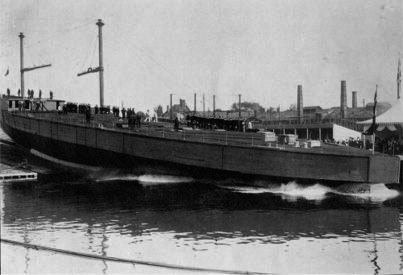 This fit her coastal duty and confirmed her “classification”. The new design was eventually approved in 1920. She had been originally laid down on 21 September 1914 at the Orlogsværftet (Royal Danish Naval Shipyard) in Copenhagen, but construction proceeded slowly and she was launched on 3 July 1918. This launch was interrupted by a stop mid-way through the slipway, for over an hour. This was before she could be freed and slide into the water. But Construction was halted a few months later and her design reconsidered. Construction only restarted in 1920 to a new design. She was at last commissioned in May 1923, nine years before being laid down.
This fit her coastal duty and confirmed her “classification”. The new design was eventually approved in 1920. She had been originally laid down on 21 September 1914 at the Orlogsværftet (Royal Danish Naval Shipyard) in Copenhagen, but construction proceeded slowly and she was launched on 3 July 1918. This launch was interrupted by a stop mid-way through the slipway, for over an hour. This was before she could be freed and slide into the water. But Construction was halted a few months later and her design reconsidered. Construction only restarted in 1920 to a new design. She was at last commissioned in May 1923, nine years before being laid down.
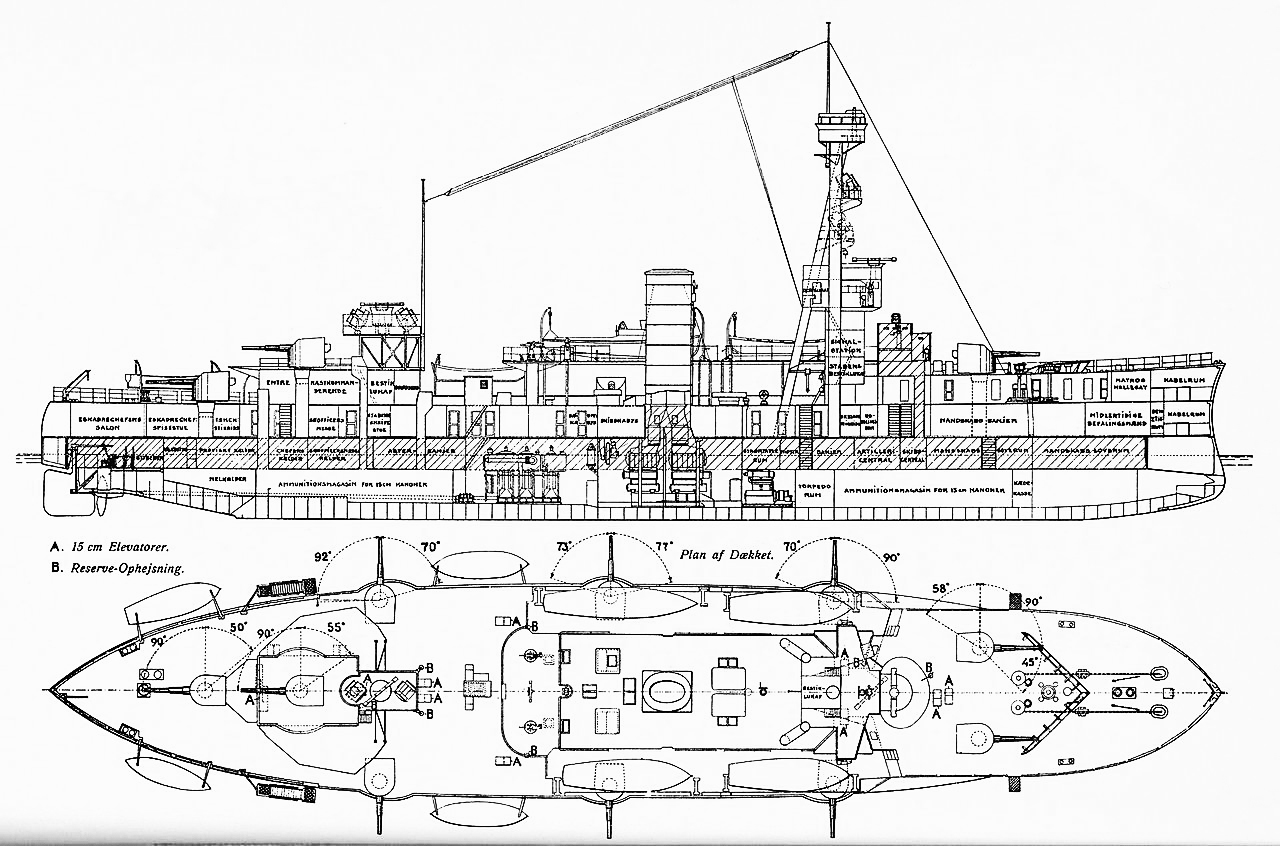
Plan of the construction/modernization of the Niels Juel
Hull and general design of the “Artilleriskibet”

Short (90 m) for a 16.3 m width, almost 1/5 ratio, her hull was divided into 10 watertight compartments and fitted with a double bottom for extra ASW protection, another adjustment inherited from WW1 lessons. The ship was called by the Danes themselves as an “artilleriskibet”, almost a gunboat in essence. Her final appearance diverged greatly from the first draft, with a tall superstructure and high freeboard, forecastle, unique funnel and tower bridge atop a communicating tube as well as her armament. The conning towwer forward of the bridge was two-stage, with the wheel section lower forward and firing station higher behind, in tandem.
She had a single mainmast on top of her military mast tripod and a single pol mast aft to support radio cables. She had three heavenly spaced sponsons guns, two fire spotting stations fore and aft with two telemeters (type unknown) atop her forward bridge and on the aft platform. He tripod supported a firing direction top.
She also had three projectors for night action: Two on the tripod, two aft on the platform close to the aft telemeter.
Her crew comprised originally 310 officers and ratings in 1924, but was expanded to 369 in WW2 due to her numerous AA additions.
They were evacuated by eight service boats: Four amidship under inner davits and four aft under outer davits.
Armour protection layout
She was protected by Krupp cemented armor made by Bethlehem Steel after an international tender for procurement, about 195 mm (7.7 in) on the belt, down to 150 mm (6 in), with 175-165 mm transverse bulkheads (6.5-7-in) to close the citadel. The shields ranged from 10 to 50 mm for the frontal arc (2 in) and the deck was 55 mm (2.1 in) thick while the conning tower was 170 mm (7 in). Overall, this was an excellent protection, even for an armoured cruiser, giving it was way superior to her own armament.
So in short:
Belt: 155–195 mm (6.1–7.7 in)
Deck: 55 mm (2.2 in)
Gun shields: 50 mm (2.0 in)
Conning tower: 170 mm (6.7 in)
Bulkheads: 165 or 175 mm (6.5 or 6.9 in)
Powerplant
There was aboard a single pair of vertical triple-expansion steam engines, driving two shafts, with three-meters diameter and three-bladed propellers. These steam engines were fed by four Yarrow boilers with superheaters, two pairs running on oil, and the second on coal. This also was a modification of the 1914 design, which was all-coal, and a lesson of WWI. The 6,000 indicated horsepower (4,500 kW) allowed only 14.5 knots (26.9 km/h; 16.7 mph) but on trials, HDMS Niels Juel was able to reach 16 knots. Her internal mixed capacity still allowed a generous 6,000 nautical miles (11,000 km; 6,900 mi) range for Denmark’s limited coastal waters, at 9 knots. She could patrol around the entire coast and back, with extra incursions in Noorwegian waters and through the Skagerrak along the Baltic German coast. This also fit her role as training cruiser.
Armament
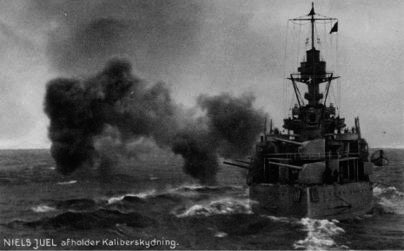 Although certainly less potent as deterrence than 12-in guns, her final armament was quick-firing and still capable to inflict damage to any incoming ship, provided she was not out-ranged. For her limited size, it was quite impressive nevertheless, and made her somewhat a “crowded” ship.
Although certainly less potent as deterrence than 12-in guns, her final armament was quick-firing and still capable to inflict damage to any incoming ship, provided she was not out-ranged. For her limited size, it was quite impressive nevertheless, and made her somewhat a “crowded” ship.
Main: 12x 15cm Bofors (1923)
There is little information about these Bofors models other than by default of Krupp, they were extremely close in design and performances to the well-known German 15 cm SK L/45.
We can deduce they were made of an A tube with two layers of hoops and an horizontal sliding-wedge breech block and Hydro-spring recoil. They used separate loading quick fire shell, for a 5-7 rpm,
Muzzle velocity of circa 840 ms (2,800 ft/s). For each broadside they could deliver six shells, four in chase, four in retreat. Ammunition aboard supply unknown.
AA: 2x 5.7cm (1936)
There was no secondary armament so they swapped directly to a pair of rapid-fire guns of small caliber to deal with aviation, also usable against ships and as saluting guns as well. But there is no information about these before 1936 when they were implemented. They assumed to be Swedish Bofors (later evolved into the 57 mm/60 (2.25″) SAK Model 1950, itself a scaled-up version of the famous 40mm Bofors).
Torpedoes
She had two beam, submerged torpedo tubes installed, firing type H torpedo fitted with a 121.5-kg (268 lb) warhead, hitting their mark up to 8,000 meters at 27 knots.
Modernizations
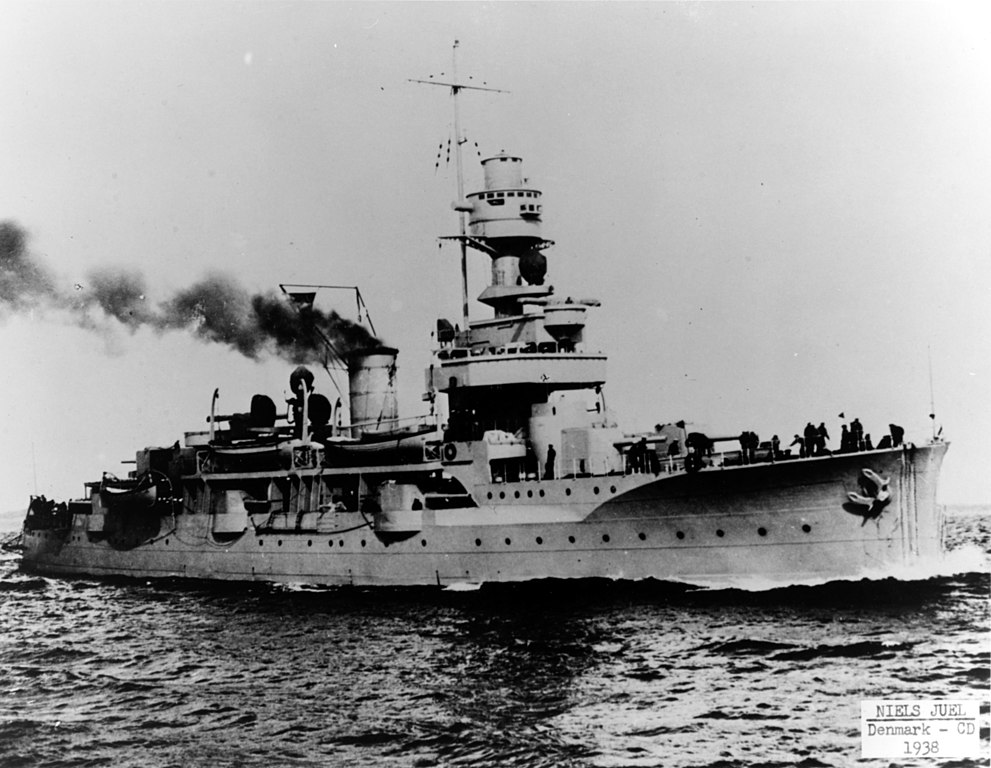
HDMS Niels Juel in 1938
Niels Juel’s first operational cruise started in May 1923. She made numerous visits and later state visits as Royal Yacht, carrying the Royal family. In this role she toured the Mediterranean in 1929.
-1929-1930: At the same time she received modifications: The two three-meter rangefinders were transferred to older ships like the Peder Skram and Olfert Fischer and she received instead a single modern modern Barr & Stroud 3.66 m coincidence rangefinder, replaced a year later by a German Zeiss 5 m coincidence rangefinder.
-She was modernized in 1935-1936, and the fire-control systems were changed again, with the tripod mast replaced by a pole mast, two-stage director-control tower. She received then a Dutch Hazemeyer gunnery director and analog gunnery computer with three Zeiss 6 m rangefinders. The 57 mm AA guns were replaced by ten Madsen 20 mm RK M/31 autocannons in five twin mounts.
Smoke screen projectors were fitted at the stern. She would also received in 1937 seven twin mount 8 mm (0.3 in) Madsen R.K. L/75 M/37 machine guns.
Her aft pole mast was replaced by two lattice extensions aft of the funnel’s top cap, supporting the wireless radio cables hanging from the mainmast forward.
-In early 1941 she received an extra pair of 40 mm Bofors AA guns (single) and in 1942 ten faster-firing Madsen 20-millimeter L/60 M/41 autocannons fitted in place of the older models.
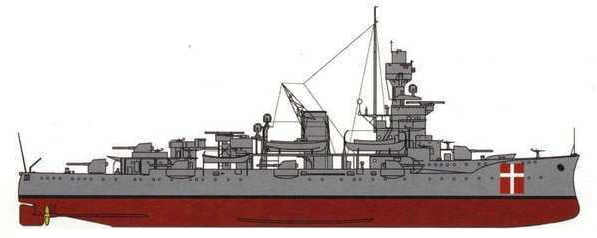
Profile in WW2, with neutrality markings (src alchetron). In reality her livery was brighter than this dark grey shown here. Personal HD profile coming.
⚙ specifications |
|
| Displacement | 3,800 long tons (3,861 t) (standard) |
| Dimensions | 90 x 16.3 x 5m (295 ft 3 in x 53 ft 6 in x 16 ft 5 in) |
| Propulsion | 2 shafts VTE, 4 Yarrow boilers oil/coal 6,000 ihp (4,500 kW) |
| Speed | 14.5 knots (26.9 km/h; 16.7 mph) |
| Range | 6,000 nmi (11,000 km; 6,900 mi) at 9 knots (17 km/h; 10 mph) |
| Armament | 10 × 150 mm (5.9 in), 2 × 57 mm (2.2 in), 2 × 450 mm (17.7 in) TTs |
| Protection | Belt 155–195, Deck: 55 mmn Gun shields 50 mm, Conning tower 170 mm, Bulkheads: 165 or 175 mm |
| Crew | 310–369 |
HDMS Niels Juel’s Career
Early Interwar Career 1924-1939
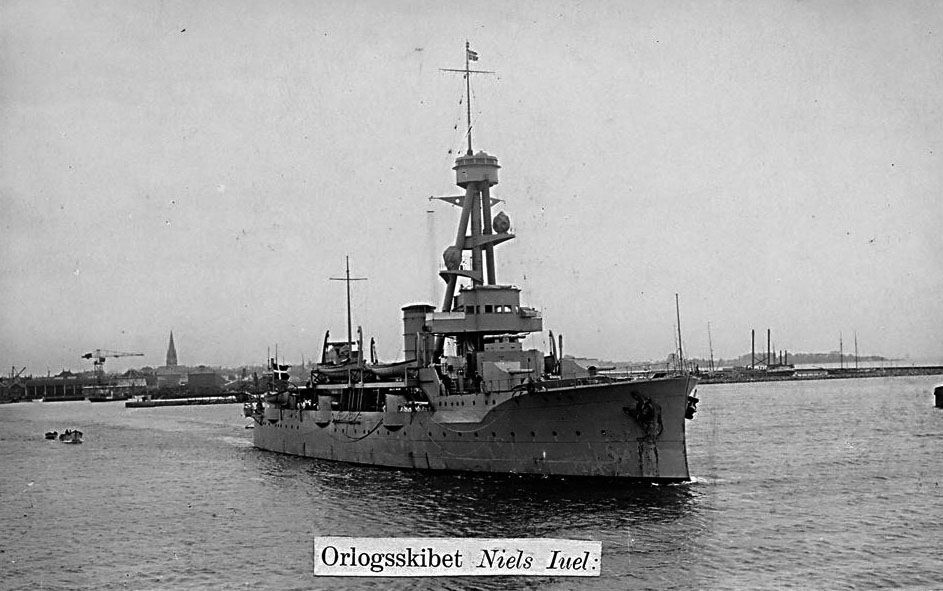
HDMS Niels Juel made her sea trials following her commission in 1923 and her shakedown cruise on 28 May with Crown Prince Frederick aboard. The brand new ship visiting the Faeroe Islands, Bergen in Norway, Leith in Scotland and Gothenburg in Sweden, before before being back home in Stockholm on 6 August.
On 21 October, after working up some issues and preparing, she made her first training cruise. She had for port calls Dartmouth (UK), Cadiz (Spain), Madeira (Portugal) Cape Verde Islands, and went south-west to South America.
On her return trip she was battered by quite a severe Atlantic storm after leaving the Azores. She rocked so much her rudder chains broke and she became unable to steer. She had to resume her trip by using output alone, turning by alternating her steam engines, until until emergency steering was rigged to resume and trip home, arriving on 23 February 1924. After repairs in Plymouth she became flagship, gunnery training squadron. Later she became flagship of the general training squadron.
In 1925, she made a short baltic cruise, visited Finland (taking part in a parade and saluting), as well as nearby Estonia, Latvia and Germany. In 1926 she cruised to the Faeroe Islands and Iceland with the royal family aboard. She was also the royal yacht for a state visit in Finland in 1928 escorted by the cruiser Heimdal, making another round of gunnery salutes as part of the Danish Squadron.
No record for 1926n 27 or 1928, but in 1929 she made an intensive training cruise into the Mediterranean making port calles in France, Spain, Italy and Libya, and Portugal on her way back, showing her range was totally adequate for these trips. She was back into her flagship, training squadron routine for the remainder of the year but on 22 May 1930 regained her status and function as royal yacht for a tour of the Faeroes and Iceland, still training naval cadets. In 1931, she made refuelling stops in her second Mediterranean cruise, and became the first Danish warship ever to visit the Black Sea via Istanbul, and stopped in Odessa. On her return trip she stopped in Greece, Italy, Algeria, and France.
Niels Juel was eventually decommissioned on 3 September 1931. It seems she was in limited commission in 1932-34 (photos shows her at sea), and she was modernized in 1935 and 1936, recommissioned on 9 July and spent the rest of 1936 in sea trials and working up her new crew.
1937 saw her as flagship of the Danish squadron in the Fleet review in Spithead for the coronation of George VI, 20 May 1937. She later took part in a fleet exercise which ended in Helsingborg, Sweden. In 1938, she led the Danish torpedo boat flotilla to Turku in Finland by August, stopped in Sønderborg (Denmarkp in September and pet here the whole training squadron. In 1939 it was planned her first training cruise to the United States cilumating with the New York World’s Fair by May. But this was cancelled due to rising tensions. She stayed trining with HDMS Peder Skram until July 1939.
By late August, she prepared a small cruise to Oslo, but it too, was cancelled. The admiralty order to prepare her for war, starting by having all shell fuzes setup for combat. Her training crew was fully completed, she received additional AA MGs soon and she was fully mobilized, joining the fleet near Aarhus. Winter ice however forced her back in Copenhagen by January 1940. The crew was soon given leave but recalled on 8 April and the 9th, the Germans invaded the country while her crew was still not all aboard. After the country surrendered after a few hours of fighting, the Germans allowed the Danes to keep their fleet and resume training in Danish waters.
Neutrality (1940-1943)
 The only waters, where the German occupying power had allowed such training cruises to be held by the ship limited her movements. In between limited fuel supplies (requisitioned, Niels Juel was not frequently at sea. During the was she was under command of 49-year-old ship captain Carl Westermann, which knew his ship well. He had for several periods been commander and second-in-command aboard, and also had several years’ experience as a torpedo boat commander.
The only waters, where the German occupying power had allowed such training cruises to be held by the ship limited her movements. In between limited fuel supplies (requisitioned, Niels Juel was not frequently at sea. During the was she was under command of 49-year-old ship captain Carl Westermann, which knew his ship well. He had for several periods been commander and second-in-command aboard, and also had several years’ experience as a torpedo boat commander.
But it was not just an experienced captain who decided to escape with ship and crew to Sweden on 29 August 1943. Carl Westermann had been a member of the Folketing since 1933, and earlier in the year 1943 had been elected as the 1st Deputy Chairman of the Folketing. The lead-up to 29 August 1943 was, from the Danish side, a clear no from the government and people’s government to continued cooperation with the German occupying power, and the increased German demands. One can therefore almost see something symbolic in the fact that the fight between NIELS IUEL and the German armed forces, from the Danish side, is led by the 1st Deputy Speaker of the Folketing, in his capacity as ship’s captain.
Operation Safari (August 1943)
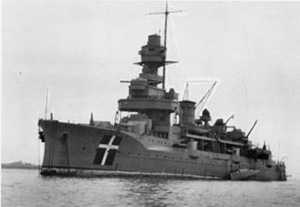 In 1943, Danish resistance to German rule hd ramped up considerably and local German authorities started to crack down on some groups, also instituting martial law on 28 August 1943, then like they did in France by November 1942, they moved to seize the Danish fleet in Copenhagen at dawn on the 29th. This übung was codenamed Operation Safari. On the 27th already, Captain Westermann was warned by the Admiralty that somehing was cooking up. The following evening he held a meeting with the ship’s officers and they agreed that ailors were to remain aboard and that the ship was prepared to leave at the shortest notice. On the 28th he still awaited orders, but on the morning of August 29, he anchored in Holbæk.
In 1943, Danish resistance to German rule hd ramped up considerably and local German authorities started to crack down on some groups, also instituting martial law on 28 August 1943, then like they did in France by November 1942, they moved to seize the Danish fleet in Copenhagen at dawn on the 29th. This übung was codenamed Operation Safari. On the 27th already, Captain Westermann was warned by the Admiralty that somehing was cooking up. The following evening he held a meeting with the ship’s officers and they agreed that ailors were to remain aboard and that the ship was prepared to leave at the shortest notice. On the 28th he still awaited orders, but on the morning of August 29, he anchored in Holbæk.
Niels Juel was preparting for departure at 4:00 am, when Carl Westermann received the radio order fro the Danish admiralty to steam to be interned in Sweden. At 04:20 the order also precised, in case she was stopped or disabled, to sink the ship.
Niels Juel left Holbæk around 06:00, setting a course for Sweden. The Germans however caught the message and sent planes, until they spotted her just after departure.
Before she could exit the Isefjord, Westermann learned the Germans claimed mining the exit -which was a bluff- to try to stop her. He proceeded anyway but soon spotted three German ships in the distance: These were the torpedo boat T17 and two E-boats, dispatched in interception. Soon also the Luftwaffe was sent in, and Ju-87 Stukas appeared.
Battle of Isefjord
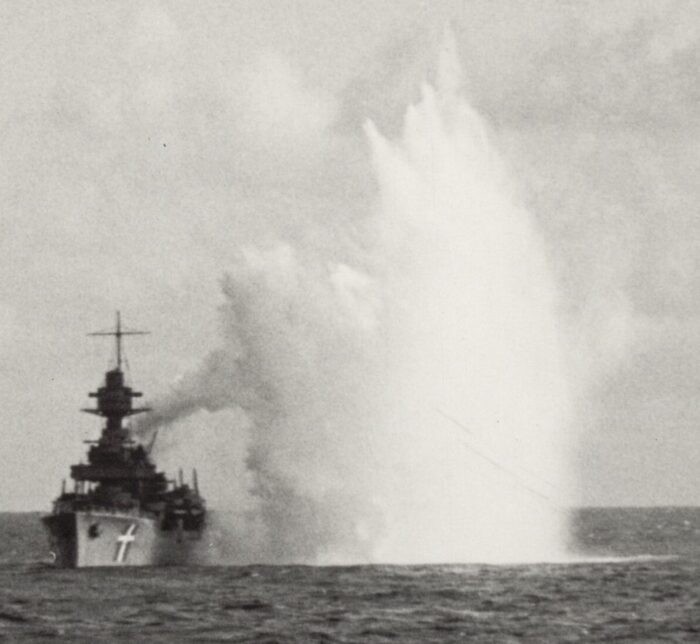
From 08:55 till 09:35 Niels Juel was repeatedly attacked by German aircraft south of Hundested. A few Stukas based in Denmark dropped bombs and used strafing. None of the bombs hit Niels Juel. There was however some rude near-misses, which badly shook her hull and and knocked out electrical power; Hull plating and bulkheads were also deformed and unhinged. Meanwhile the crew manning the AA put up quite a fight, but the machine guns could do little. Pilots respected however her two 40 mm Bofors, backed by several 20 mm guns. it is not known is she damaged any of her assaulters, but none was reported down. In all she had five Danish sailors injured, rather seriously, no dead until artillery quartermaster H. E. Andreasen a few days later from the injuries he had sustained in the last air raid.
Realising there was little hope of reaching Sweden now, between these air attacks and “greeting committee” of three fast TBs blocking his way, Westermann decided to save his crew and run his ship aground near Nykøbing Sjælland. The crew tried to scuttle the ship by using the explosive charges, but the attempt failed. Next it was decided to flood the magazine, and all the sea-cocks to flood the rest of the hull and systematically destroying all sensible or useful equipment before the Germans could takje over her. Indeed soon the TBs arrived on the scene and capttured the entire crew.
Before this, Commander-in-Chief Carl Westermann, received unconfirmed information that the Danish fleet at Holmen, Copenhagen had been sunk/scuttled in the morning hours.
At 10:48 NIELS IUEL was effectively beached, sea cocks opened, and she slowly settled to the bottom. The crew was made prisoner only the following day, on August 30th, leaving them plenty of time to scuttle the ship as best they could.
Kriegsmarine service and Postwar Fate (1944-52)
As shelied grounded, a Danish salvage company was sent by to inspected the wreck only a few days after her sinking. They failed to see see any damage to the hull, rudder or propellers, so ensuring she could be refloated. But they noted she was still heavily flooded, up to 1.5 meters (4 ft 11 in) below the armored deck. The Germans wanted to have her rised and rebuilt her likely into a Flakschiff, and commanded a German company to proceed. By October 1943, they did so using pumps, and she was refloated and towed it to Kiel, Germany, for repair and transformation.
She was however disarmed and renamed Nordland, and commissioned into the Kriegsmarine in September 1944, not as Flakschiff but stationary training ship based in Stolpmünde (modern Ustka, in Poland). Her removed armament was not lost, it was used for close defense of a number of German artillery positions on the west coast of Jutland.
On 18 February 1945 she steamed to Kiel to avoid capture by the raidly advancing Russian army. By 3 May 1945 she was scuttled in the Eckernførde inlet. The wreck was partially dismantled by unauthorized scrappers before the Danes officially sold the wreck to a German company that BU her in 1952, after removing everything above the sea bed and left the bottom wreck, no longer a navigation hazard, still laying under 28 meters (92 ft) of water.
Read More
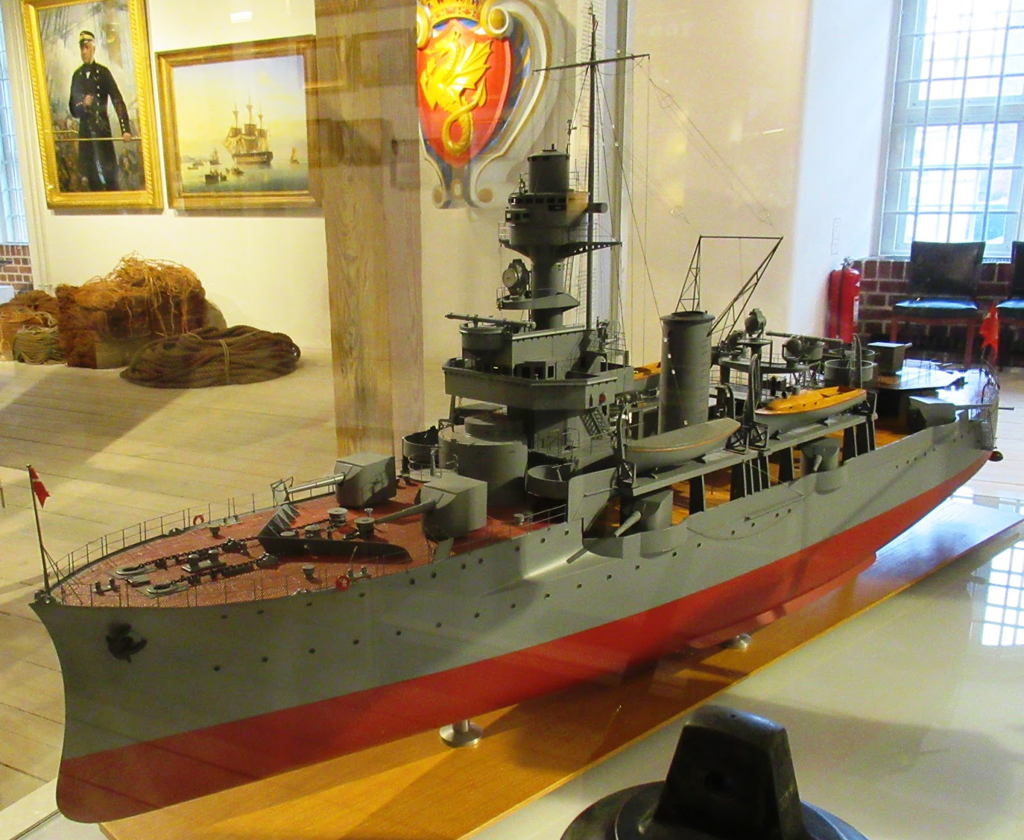
Admiralty Model of the Niels Juel at the Royal Arsenalen Museum (2017 photo)
Books
Westerlund, Karl-Erik (1985). “Denmark” in J. Gardiner Conway’s all the world’s fighting ships 1906-1921
Campbell, John (1985). Naval Weapons of World War II. Annapolis, Maryland NIP
Wisman, Tom (2018). “Niels Juel: ‘A Funny Little Danish Warship'”. Warship 2018. Oxford, UK: Osprey.
Links
On navalhistory.dk
navalhistory.dk/ Niels_Juel
wikipedia.org
navweaps.com/ swedish ordnance
on navypedia.org/
worldmilitary.net/
alchetron.com
worldnavalships.com
milhist.dk/
commons.wikimedia.org/
arkiv.dk/vis/3343844
Painting Gallery


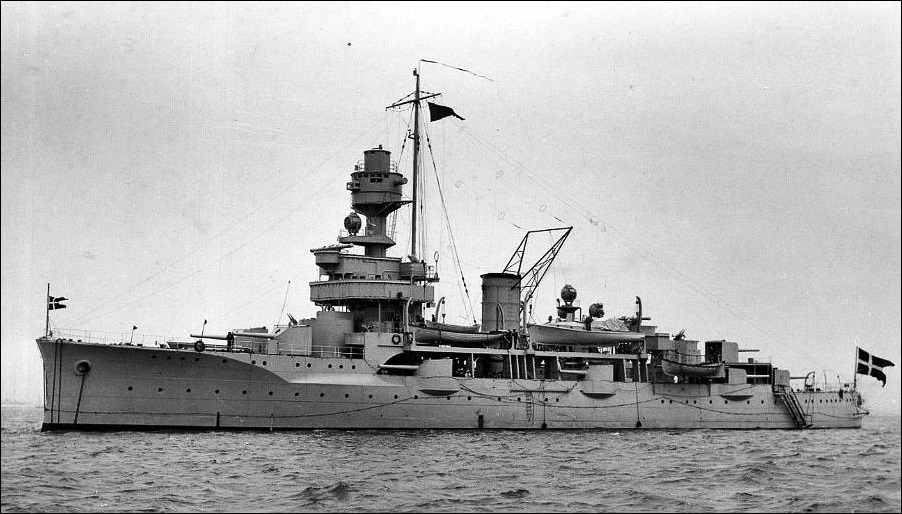
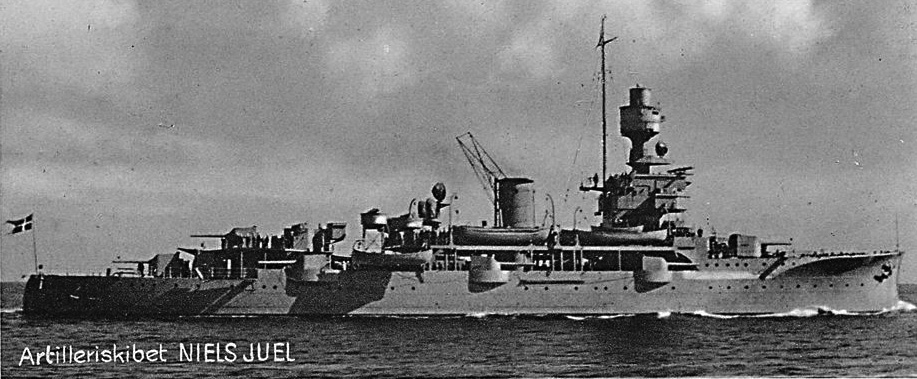
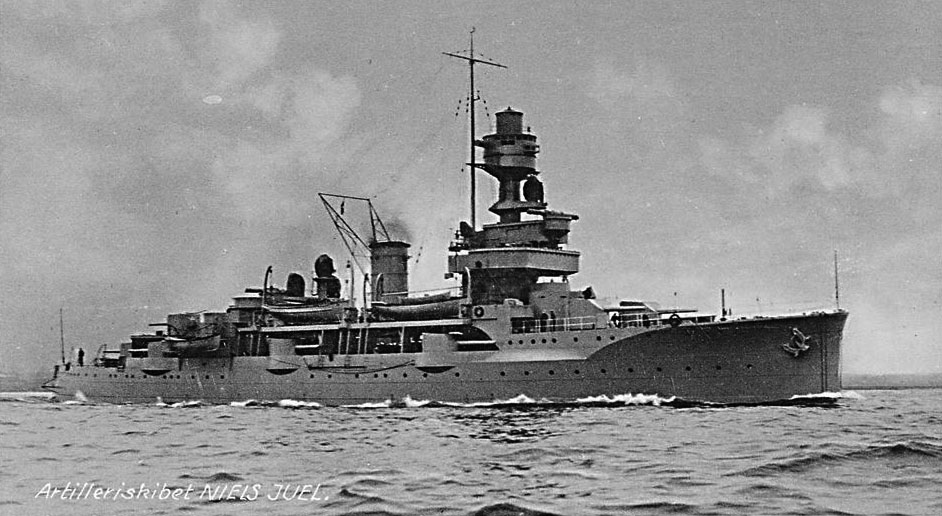


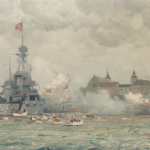

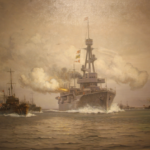
 Latest Facebook Entry -
Latest Facebook Entry -  X(Tweeter) Naval Encyclopedia's deck archive
X(Tweeter) Naval Encyclopedia's deck archive Instagram (@navalencyc)
Instagram (@navalencyc)





 French Navy
French Navy Royal Navy
Royal Navy Russian Navy
Russian Navy Armada Espanola
Armada Espanola Austrian Navy
Austrian Navy K.u.K. Kriegsmarine
K.u.K. Kriegsmarine Dansk Marine
Dansk Marine Nautiko Hellenon
Nautiko Hellenon Koninklije Marine 1870
Koninklije Marine 1870 Marinha do Brasil
Marinha do Brasil Osmanlı Donanması
Osmanlı Donanması Marina Do Peru
Marina Do Peru Marinha do Portugal
Marinha do Portugal Regia Marina 1870
Regia Marina 1870 Nihhon Kaigun 1870
Nihhon Kaigun 1870 Preußische Marine 1870
Preußische Marine 1870 Russkiy Flot 1870
Russkiy Flot 1870 Svenska marinen
Svenska marinen Søværnet
Søværnet Union Navy
Union Navy Confederate Navy
Confederate Navy Armada de Argentina
Armada de Argentina Imperial Chinese Navy
Imperial Chinese Navy Marinha do Portugal
Marinha do Portugal Mexico
Mexico Kaiserliche Marine
Kaiserliche Marine 1898 US Navy
1898 US Navy Sovietskiy Flot
Sovietskiy Flot Royal Canadian Navy
Royal Canadian Navy Royal Australian Navy
Royal Australian Navy RNZN Fleet
RNZN Fleet Chinese Navy 1937
Chinese Navy 1937 Kriegsmarine
Kriegsmarine Chilean Navy
Chilean Navy Danish Navy
Danish Navy Finnish Navy
Finnish Navy Hellenic Navy
Hellenic Navy Polish Navy
Polish Navy Romanian Navy
Romanian Navy Turkish Navy
Turkish Navy Royal Yugoslav Navy
Royal Yugoslav Navy Royal Thai Navy
Royal Thai Navy Minor Navies
Minor Navies Albania
Albania Austria
Austria Belgium
Belgium Columbia
Columbia Costa Rica
Costa Rica Cuba
Cuba Czechoslovakia
Czechoslovakia Dominican Republic
Dominican Republic Haiti
Haiti Hungary
Hungary Honduras
Honduras Estonia
Estonia Iceland
Iceland Eire
Eire Equador
Equador Iran
Iran Iraq
Iraq Latvia
Latvia Liberia
Liberia Lithuania
Lithuania Mandchukuo
Mandchukuo Morocco
Morocco Nicaragua
Nicaragua Persia
Persia San Salvador
San Salvador Sarawak
Sarawak Uruguay
Uruguay Venezuela
Venezuela Zanzibar
Zanzibar Warsaw Pact Navies
Warsaw Pact Navies Bulgaria
Bulgaria Hungary
Hungary

 Bundesmarine
Bundesmarine Dutch Navy
Dutch Navy Hellenic Navy
Hellenic Navy Marina Militare
Marina Militare Yugoslav Navy
Yugoslav Navy Chinese Navy
Chinese Navy Indian Navy
Indian Navy Indonesian Navy
Indonesian Navy JMSDF
JMSDF North Korean Navy
North Korean Navy Pakistani Navy
Pakistani Navy Philippines Navy
Philippines Navy ROKN
ROKN Rep. of Singapore Navy
Rep. of Singapore Navy Taiwanese Navy
Taiwanese Navy IDF Navy
IDF Navy Saudi Navy
Saudi Navy Royal New Zealand Navy
Royal New Zealand Navy Egyptian Navy
Egyptian Navy South African Navy
South African Navy






























 Ukrainian Navy
Ukrainian Navy dbodesign
dbodesign